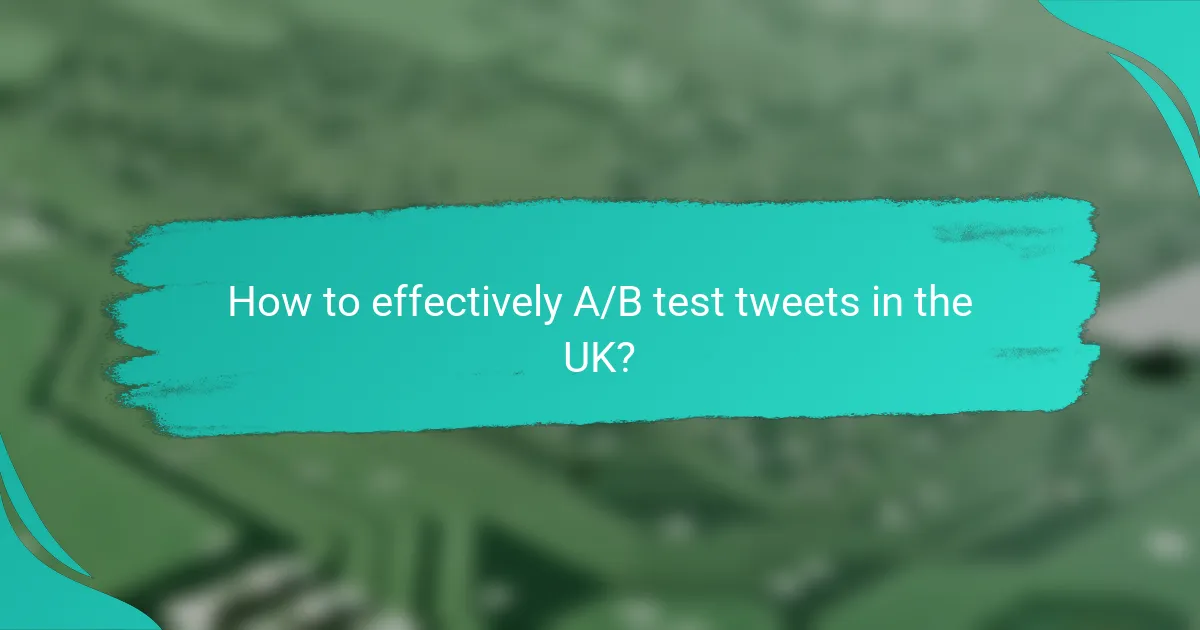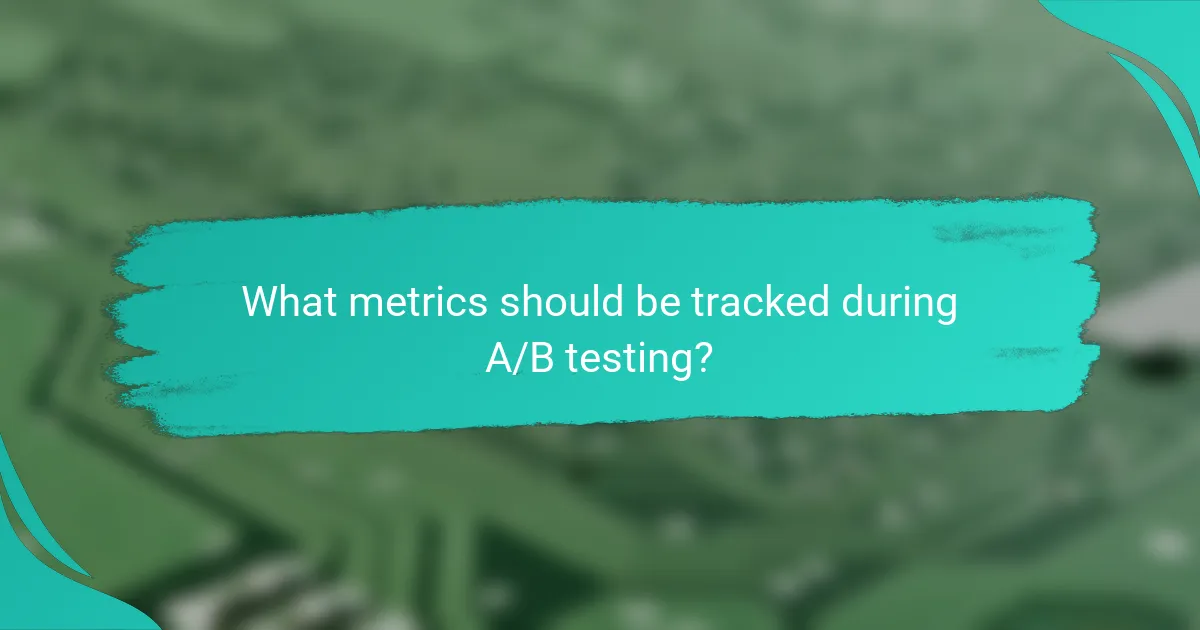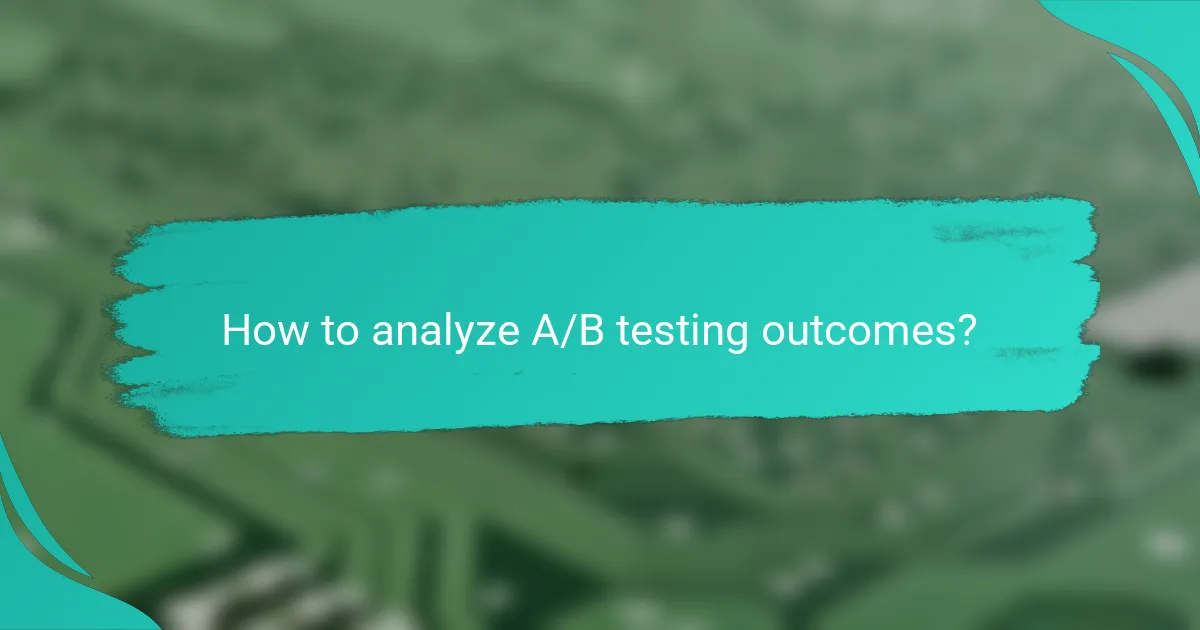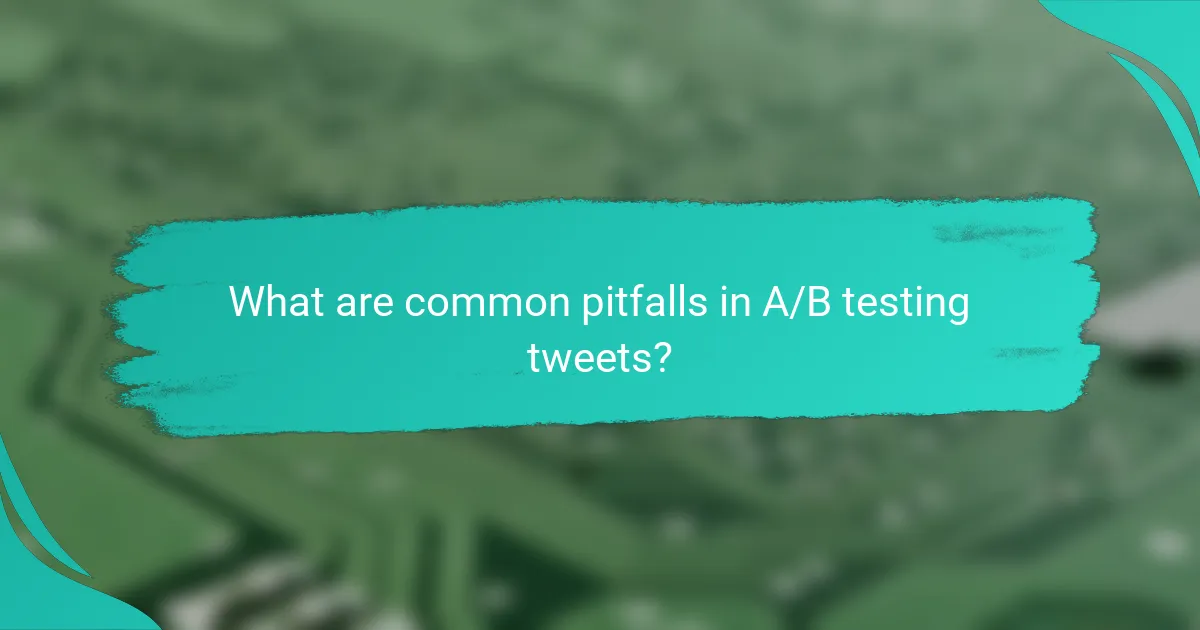A/B testing tweets is a powerful strategy for optimizing social media engagement and reach. By comparing different tweet variations, marketers can identify which elements resonate most with their audience, using key metrics such as engagement rate and click-through rate to guide their decisions. This process involves careful planning and execution, allowing for data-driven improvements in tweet performance.

How to effectively A/B test tweets in the UK?
To effectively A/B test tweets in the UK, focus on comparing two or more variations of a tweet to determine which performs better based on specific metrics. This process involves careful planning, execution, and analysis to optimize engagement and reach.
Identify target audience segments
Identifying target audience segments is crucial for A/B testing tweets. Start by analyzing your existing followers and their demographics, interests, and behaviors. Use Twitter’s audience insights to segment your followers into groups, such as age, location, or interests, allowing you to tailor your tweets for maximum relevance.
For example, if you have a product appealing to both young adults and older consumers, create separate tweets for each segment to see which resonates more. This targeted approach can significantly enhance engagement rates.
Choose tweet variables to test
Selecting the right tweet variables is essential for effective A/B testing. Common variables include tweet copy, images, hashtags, and posting times. Each of these elements can influence how your audience interacts with your content.
For instance, you might test two different headlines or images to see which garners more clicks or retweets. Keep the variables limited to one or two at a time to ensure clear results.
Determine sample size for tests
Determining the appropriate sample size for your A/B tests is vital to achieving statistically significant results. A larger sample size generally leads to more reliable insights, so aim for at least a few hundred interactions per variant.
Consider your overall follower count and engagement rates when deciding on sample sizes. If your audience is smaller, you may need to run tests over a longer period to gather enough data for meaningful conclusions.
Set clear objectives for testing
Setting clear objectives for your A/B tests helps guide your strategy and focus your analysis. Define what success looks like for each test, whether it’s increasing retweets, clicks, or overall engagement.
For example, if your goal is to boost website traffic, track the click-through rates of each tweet variant. Having specific objectives allows you to measure performance accurately and make informed decisions for future campaigns.
Use Twitter Analytics for insights
Utilizing Twitter Analytics is essential for gaining insights from your A/B tests. This tool provides detailed metrics on tweet performance, including impressions, engagements, and engagement rates.
After running your tests, analyze the data to identify which tweet variant performed best against your objectives. Look for patterns in the data that can inform your future tweet strategies, such as optimal posting times or preferred content types.

What metrics should be tracked during A/B testing?
During A/B testing, it’s crucial to track various metrics to evaluate the effectiveness of different tweet strategies. Key metrics include engagement rate, click-through rate, conversion rate, impressions, and follower growth, each providing insights into user interaction and overall performance.
Engagement rate
The engagement rate measures how actively users interact with your tweets, including likes, retweets, and replies. A higher engagement rate indicates that your content resonates well with your audience. Aim for engagement rates in the low to mid-single digits for effective tweets.
To calculate the engagement rate, divide the total engagements by the total impressions and multiply by 100. This metric helps identify which tweet variations generate more interaction.
Click-through rate
Click-through rate (CTR) reflects the percentage of users who click on links within your tweets. A higher CTR suggests that your call-to-action is compelling and relevant to your audience. Typical CTRs for tweets can range from 1% to 5%, depending on the content and audience targeting.
To improve CTR, use clear and enticing language in your tweets, and ensure that the linked content is valuable and aligned with user expectations. A/B testing different link placements or wording can help optimize this metric.
Conversion rate
The conversion rate tracks the percentage of users who complete a desired action after clicking through your tweet, such as signing up for a newsletter or making a purchase. This metric is vital for assessing the effectiveness of your overall marketing strategy. Conversion rates can vary widely but aim for at least 2% to 5% for successful campaigns.
To enhance conversion rates, ensure that your landing pages are optimized for user experience and relevant to the tweet’s content. Testing different offers or incentives can also yield better results.
Impressions
Impressions indicate how many times your tweets were displayed to users, regardless of whether they interacted with them. This metric helps gauge the reach of your content. A good number of impressions can range from thousands to millions, depending on your follower count and engagement strategies.
To increase impressions, consider posting at optimal times for your audience and using relevant hashtags. A/B testing different posting times can help identify when your audience is most active.
Follower growth
Follower growth measures the increase in your Twitter followers over a specific period. A steady increase in followers indicates that your content is attracting and retaining interest. Aim for a growth rate of around 1% to 3% per month for sustainable growth.
To boost follower growth, consistently post engaging content and interact with your audience. A/B testing different content types, such as polls or images, can help determine what attracts more followers.

What are the best strategies for A/B testing tweets?
The best strategies for A/B testing tweets involve experimenting with various elements to determine what resonates most with your audience. Key areas to focus on include tweet formats, posting times, hashtag usage, and the incorporation of visuals.
Test different tweet formats
Testing different tweet formats can reveal which style engages your audience more effectively. Consider variations such as questions, statements, or polls. For instance, a direct question may prompt more interaction than a simple announcement.
Use A/B testing to compare formats by posting similar content in different styles. Track engagement metrics like retweets, likes, and replies to identify the most successful format.
Experiment with posting times
Posting times can significantly impact tweet visibility and engagement. Analyze your audience’s online activity to determine peak times for posting. Generally, late mornings and early evenings during weekdays tend to yield higher engagement rates.
Conduct A/B tests by scheduling identical tweets at different times. Monitor the performance to find optimal posting windows that maximize reach and interaction.
Utilize hashtags effectively
Effective hashtag usage can enhance the discoverability of your tweets. Test different numbers of hashtags, as well as their relevance to your content. Research shows that one to three hashtags often perform best, avoiding clutter while still reaching a broader audience.
Experiment with branded hashtags versus trending ones to see which drives more engagement. Track the performance of tweets with varying hashtag strategies to refine your approach.
Incorporate visuals in tweets
Incorporating visuals such as images, GIFs, or videos can significantly boost engagement rates. Tweets with visuals typically receive higher interaction compared to text-only tweets. Aim to include a relevant image or video that complements your message.
Test different types of visuals to see what resonates with your audience. For example, compare a tweet with an infographic to one with a simple image to determine which garners more engagement. Monitor metrics like shares and likes to evaluate effectiveness.

How to analyze A/B testing outcomes?
Analyzing A/B testing outcomes involves comparing the performance of different tweet variations to determine which one achieves better engagement or conversion rates. This process helps refine future marketing strategies based on data-driven insights.
Compare performance against benchmarks
To effectively analyze A/B testing outcomes, start by establishing benchmarks for key performance indicators (KPIs) such as click-through rates, retweets, and likes. These benchmarks can be derived from historical data or industry standards, providing a reference point for evaluating your tweet variations.
For example, if your average engagement rate is around 2%, a new tweet variation that achieves 3% engagement may indicate a successful change. Always consider the context of your benchmarks, as they can vary significantly across different industries or audiences.
Identify statistically significant results
Determining statistical significance is crucial to ensure that the observed differences in performance are not due to random chance. Use statistical tests, such as the t-test or chi-square test, to analyze the results and confirm whether the variations yield meaningful differences.
A common rule of thumb is to aim for a confidence level of 95% or higher. This means that there is only a 5% chance that the results could occur randomly. Tools like online calculators can simplify this process, allowing you to input your data and receive quick insights.
Adjust future strategies based on findings
Once you have analyzed the A/B testing outcomes, use the insights gained to refine your future tweet strategies. Identify elements that contributed to the success of the winning variation, such as tone, imagery, or timing, and incorporate these into your upcoming campaigns.
Additionally, avoid making drastic changes based on a single test. Instead, consider running multiple tests over time to gather more data and confirm trends. This iterative approach helps build a more robust understanding of what resonates with your audience, ultimately leading to better engagement and conversion rates.

What are common pitfalls in A/B testing tweets?
Common pitfalls in A/B testing tweets include inadequate sample sizes, unclear objectives, and failing to isolate variables. These mistakes can lead to misleading results and ineffective strategies.
Inadequate Sample Size
A small sample size can skew results, making it difficult to draw reliable conclusions. Aim for a sample that is large enough to represent your audience, ideally in the low hundreds to thousands, depending on your follower count.
Testing with too few participants may result in high variability, which can mask the true performance of your tweets. Always calculate the minimum sample size needed for statistical significance before starting your tests.
Unclear Objectives
Without clear objectives, it’s challenging to determine what success looks like. Define specific goals for each A/B test, such as increasing engagement rates or click-through rates, to guide your analysis.
Setting vague goals can lead to confusion and misinterpretation of results. Use SMART criteria (Specific, Measurable, Achievable, Relevant, Time-bound) to create focused objectives for your testing.
Failing to Isolate Variables
Testing multiple variables at once can complicate your results. Focus on one element at a time, such as the tweet’s wording or image, to accurately assess its impact on performance.
For example, if you change both the image and the call-to-action in a single test, you won’t know which change drove any observed differences. Isolate variables to pinpoint what works best.